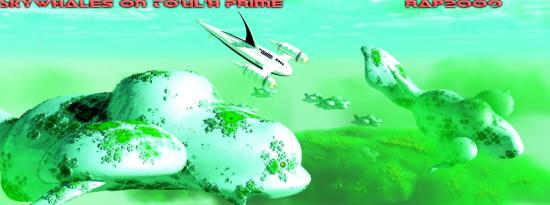BY LETTER
Tohul (To'ul'h Homeworld)
Galactography > Sephirotic Empires > Caretaker Gods
Galactography > Regions of Space > Middle Regions/Hinter-regions
Galactography > Sephirotic Empires > Mutual Progress Association
Galactography > Systems and Worlds > Systems & Worlds S - T
Sophonts > Xenosophonts > To'ul'hs
Galactography > Regions of Space > Middle Regions/Hinter-regions
Galactography > Sephirotic Empires > Mutual Progress Association
Galactography > Systems and Worlds > Systems & Worlds S - T
Sophonts > Xenosophonts > To'ul'hs
Homeworld of the To'ul'hs - a hot gardenworld | |
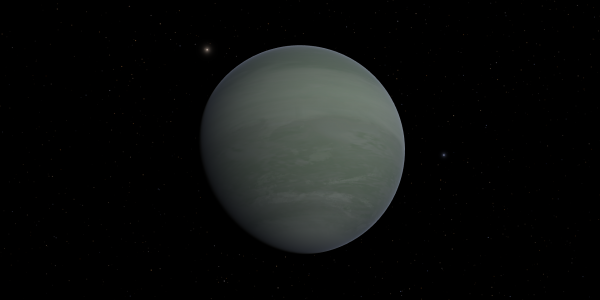 Image from The Astronomer | |
| Tohul, as seen from space | |
Tohul - Data Panel | |
| System | Name: H'tat'sa'thoss |
|---|---|
| Planet | Name: Tohul Orbital characteristics: - Semi-major axis: 245.6 Gm (1.642 AU) - Orbital period: 2.030 years - Eccentricity: 0.018 Physical characteristics: - Type: TholiTerrestrial LapiMinervan EstuaThermal AquaGaian - Mass: 8.74E+24 kg (1.464 x Earth) - Radius: 7,085 km (1.112 x Earth) - Density: 5,870 kg/m^3 - Mean surface acceleration: 11.61 m/s^2 (1.184 gees) - Rotation period: 19.05 hours - Obliquity: 7° - Albedo: 0.48 - Mean insolation: 686 W/m^2 (0.504 x Earth) - Mean surface temperature: 361 K Atmosphere: - Surface pressure: 1.936 MPa (19.36 bar) - Composition: 57.1% carbon dioxide, 23.3% nitrogen, 19.3% oxygen, 0.2% water, 0.1% argon, trace amounts of sulfur dioxide, carbon monoxide, neon, helium, hydrogen, and methane. Satellites: none |
| Planetology | Geography: Sluggish-lid tectonics dominate Tohul's surface. The planet's crust is broken into plates whose languish motion is driven by the flow of the hot mantle beneath. Subduction is localized, and plate boundaries are not always distinct. Many of Tohul's features are governed by plate tectonics such as broad mountain ranges and volcanic arcs, but there are also older geographical features - volcanic highlands, uplifted plateaus, and coronae, which were formed by mantle plumes. In general, Tohul's topography is flatter than Earth's, although due to its lower sea levels, it possesses many high elevation mountains. Atmosphere and Climate: At sea level, the air pressure is 19.36 bar. Clouds are ubiquitous, as are many layers of organic particulate - together with airborne organisms, they block on average 99% of starlight from reaching the surface, rendering the surface moody, although not completely dark. The high density of air at the surface allows it to carry significant force, even at a mere breeze. Loose soil is easily carried away by these winds, resulting in frequent dust storms. Rain is also a common occurrence, carrying with it organic particulates from the upper troposphere - this motion helps to drive strong thunderstorms, though due to the height of the clouds lightning rarely strikes the surface. Seasonal changes in the upper troposphere cause fairly predictable patterns in precipitation down on the surface. Because of the high temperatures and thicker atmosphere, cyclones on Tohul are both powerful and long lasting, with some surviving for months or even years. Hydrosphere: Water covers some 45% of Tohul's surface, predominantly in a high salinity world ocean. In addition to this, there are several large endorheic basins with isolated seas and lakes of much more variable salinity. Tohul's water is also rather acidic due to dissolved carbon dioxide. Tohul's seas and oceans experience only weak tides, owing to the significant distance from the star and lack of moons. Temperature: At sea level, Tohul's temperature is 361 Kelvin (88 °C) on average. Altitude has by far the largest influence on temperature; deep in the oceanic basins, surface temperature can rise as high as 369 Kelvin (96 °C), while on the tallest mountain summits it can drop to just 293 Kelvin (20 °C). Temperature at any given location tends to remain relatively constant year-round, within around 5 Kelvin. The cause of variation is largely due to weather, but diurnal variation does become more pronounced at higher elevations. Due to the thick atmosphere, latitudinal variation has only minimal effects on temperature, and seasonal variations are mild even at higher altitudes due to the planet's low axial tilt. Above Tohul's clouds, and out of the thick insulating lower troposphere, temperatures drop to well below freezing. Biology and Ecology: Complex lifeforms on Tohul have adapted to thrive in a wide range of temperatures, allowing them to colonize both the surface and the atmosphere. Surface life is thermophilic by Earth standards, while tropospheric lifeforms are equally extreme psychrophiles. Photosynthesis takes place in the middle and upper layers of the troposphere, which is teeming with 'forests' of skyplankton, while the surface ecosystem is based on detritivores and decomposers. |
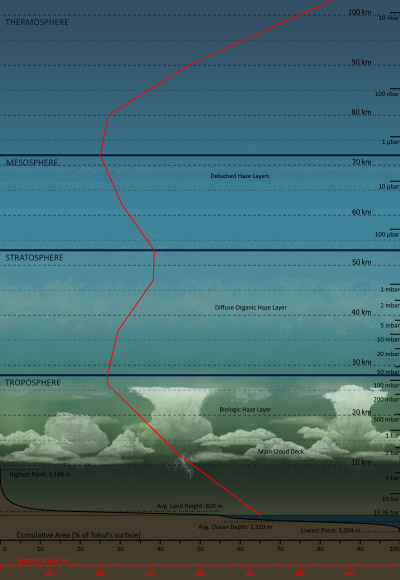 Image from Dangerous Safety |
| Polity | Name: Tohul Symbol: A To'ul'h in 'flight' Affiliation: Caretakerist Founded/Colonized: Discovered by Terragens 3831 AT; present rule established in 4645 AT. Timekeeping: Many local calendars. The ancient To'ul'h standard ceremonial calendar ('Ha'ts'ul), used as a common point of reference by all civilizations, has been in use since 24,550 BT. It is based solely on the To'ul'h diurnal period, and does not correspond exactly to the solar year. There is a 512 To'ul'h day 'year' divided into 8 portions of 64 days each; each day is divided into 8 'hours', subdivided into 8 units with no Terragen equivalent (about 18 minutes a piece) and further divided into 8 'minutes' of about 2 and a quarter Terragen minutes duration. Each day is measured from noon to noon. All To'ul'h time units use powers of 8, in consonance with the base 8 number system. |
|---|---|
| Population Demographics | Surface: 170 million; all are nearbaseline To'ul'hs Orbitals: 800 million, including many transient tourists, pilgrims, researchers, and associated service personnel; predominantly nearbaseline To'ul'h or post-To'ul'h |
| Government and Administration | Government Type: AIocracy; local government may be any traditional To'ul'h form Administrative Divisions: Many thousands of local nations/tribes/associations National holidays: None are universal Constitution: Compact of Eden, To'ul'h variant; many local documents Legal system: Varies; rare overrides by O'hoth'so'toh Foreign Policy: Isolationist |
| Overseer | Name: O'hoth'so'toh ('Smoking Mirror') Ethos: Caretakerism; moderately isolationist Current allegiance: Allied with some other Caretakerist factions |
| Economics and Local Infrastructure | Economy: many local variations Currency: none universal; many local variations Major Industries: tourism, various memetic exports, biological research Angelnetting: full angelnet with utility fog is rare outside some small portions of the major cities; O'hoth'so'toh is reputed to be aware of all activity within the biosphere, but direct interventions are rare |
| Major Orbital Structures | H'tat'sa'tho'soss (space ring): offers Terragen, To'ul'h and Muuh habitats; reconstructed 4646 AT from the original, which was destroyed in the Spacer/Homeworlder wars Eithne(O'Neill colony): offers Terragen and To'ul'h habitats; historically important |
| Psyche, Art, Culture | Metapsychology and Metaethics: Highly variable; most are pre-contact To'ul'h schools of thought. Religion/Ideology: Variable; mostly traditional To'ul'h forms. Language: To'ul'ho'lo'ss is a common language; there are many hundreds of local languages. Aesthetics/Architecture/Style: Highly variable; many traditional pre-contact To'ul'h and some post contact To'ul'h styles. |
| Travel | Stargates: 10 metre gate to Morogai (Ho'th'lhu'ooht) Beamrider Network: the system is host to 8 local cycles Spaceports: Shuttle service only, from orbital habs to designated landing sites. Hazard Rating: 0.1 for ordinary visitors; up to 10 for attempts to violate To'ul'hese version of the Compact of Eden (see Caretaker Gods entry). Visa Restrictions: No permanent residents are allowed; local copy and reproduction rights are limited to natives of Tohul Freedom of Movement: All travel by foreigners is subject to approval by Smoking Mirror or eir agents. Local law and custom may also place significant restraints. Environmental Requirements: All travellers should be equipped to survive To'ul'h standard conditions. Sites of Interest: Eithne and other important post-contact historical sites in near orbit; many thousands of cultural, religious, and historical sites from pre and post contact periods, many in active use. |
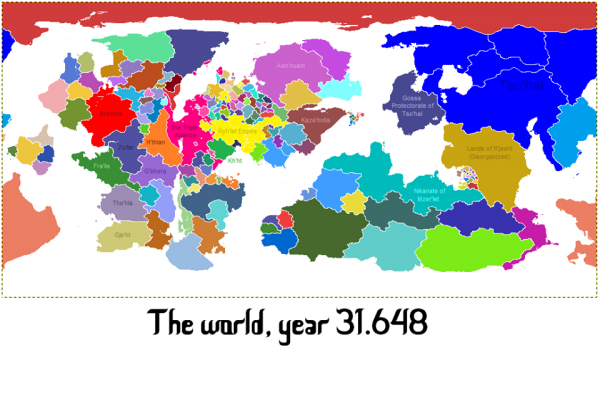 Image from Enrique Lescure | |
| Political Map of Tohul; with date in the To'ul'h calendar | |
Overview
Tohul is one of the great Garden Worlds of the Terragen sphere, and by far the richest of the known biospheres of its type. It is the origin of the first living technogenic species to be encountered by Terragens, a species that already had an unbroken chain of civilizations ten times longer than the entire history of humanity on Earth when it was contacted. Though because of the nature of their homeworld the To'ul'h had not yet generated Industrial or Interplanetary level technologies, their alien arts and philosophies had a huge impact at the time of discovery. The To'ul'h homeworld is still one of the great Wonders of the Terragen Sphere. Like Old Earth, it has come under the protection of one of the Caretaker Gods. Also like Old Earth it is valued in the present age primarily as a preserve for cultural and natural diversity, and has little direct political sway in the modern milieu. However, it does see a steady stream of To'ul'h pilgrims and Terragen or post-To'ul'h researchers.Impressions and Appearances
From space, Tohul is a brilliant green-white ball. The green cloudforests and masses of skyplankton tinge the atmosphere wherever there is an upwelling from the layers below. In the upper levels, cloudforests may be hundreds of hectares in extent, and schools of skywhales float by the millions. Floating and flying life forms of all kinds are numerous. At these heights, ordinary Terragen bionts can move about with minimal equipment or light body modifications. Deeper down, the atmosphere becomes progressively hotter, dustier, and dimmer. In the greenish murk of the midlevels, there are many floating masses of sessile filter-feeders, and plant-like life is rare. The sky grows progressively red and dim as one descends to the surface, the remaining light is more diffuse, and the temperature gradually rises. Even on the highest mountains temperatures on the surface are high enough to poach the flesh of a typical Terragen biont or cause fatal malfunctions in standard vecs. By day, even at noon, the light on the surface is dim; an unaugmented human can barely see well enough to make out large or nearby objects. Sounds are astoundingly loud, and even the slightest breeze has the strength of a cyclone in the dense atmosphere. The dusty air and muddy rains feed a surface ecology based on saprophytes and detritivores.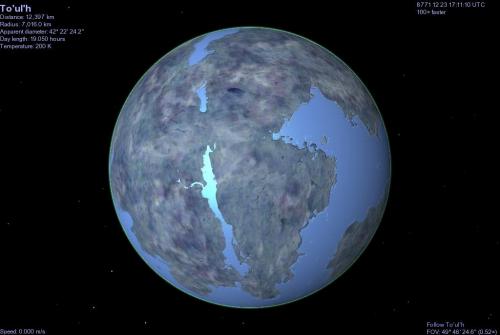 Image from Steve Bowers | |
| Tou'ul'h Prime (Tohul) without clouds | |
Planetology
At 1.46 Terran masses, To'ul'h is on the large size for a terrestrial planet, and it also received a significant charge of volatiles during its early development. It has a rapid spin rate and a strong magnetic field, and orbits a late G type star. Most importantly, it developed an oxygen-bearing atmosphere relatively early in its history. These factors combine to make it the richest biosphere of its kind, the archetypical To'ul'h World to which all other natural examples are compared. Like other worlds of this type it has a hot and wet atmosphere, but has avoided a runaway greenhouse effect and desiccation such as seen on typical Cytherean worlds. Like any terrestrial class world with a hot interior and liquid water at its surface, it exhibits plate tectonics, with a pattern of continents and ocean basins. However, the ocean basins are only half-full, and the continents are plateaus. Thus land surfaces fall into one of two distinctive types according to whether they are on these plateaus or in the basins that hold the oceans.The lowlands of Tohul are all those areas below the average level of the continental shelves; everything from the continental rise on down to the level of the local seas, nearly 3 kilometres below. They are relatively hot, at about 140°C, and their weather is relatively humid. The underlying geology consists primarily of basaltic rocks where it is not covered in thick layers of sediment. Where that sediment forms rock it is primarily sandstone or shale, often carbonaceous. Carbonates such as limestone or dolomite are very rare, and significant deposits of coal and oil are unknown. Areas corresponding to the abyssal plains or the subduction trenches are covered in water, but there are significant areas of land as well. Lowland areas are of two general types. The first corresponds to the mid-ocean ridges of a more standard Gaian world. These lands are riddled with volcanoes and hot springs, and prone to frequent earthquakes. The topography is rough, and consists of large islands with complex coastlines and many volcanoes, or of numerous small islands. The mineral-rich soils there are often the launching point for colonies of floating life forms. The second land type corresponds to the continental rise and lower continental shelf, and consists of broad coastal plains and marshes laced by meandering rivers and covered in thick deposits of sediment from the continental plateaus above. Ground-based saprophytic life reaches its largest sizes there, and "forests" of seed and spore dispersing structures are a major feature of the landscape. This second type of terrain is bordered on one side by the sea and on the other by the three kilometre high mountains of the continental slope. The mountains are deeply dissected by the rivers that flow down from the continental plateau above. There are many deep gorges, rapids, and gigantic waterfalls in this transitional region between lowlands and uplands.
The uplands correspond to the continents of a more standard Gaian planet, and like that of any such continent the underlying geology is granitic rock, with deposits of sedimentary rocks similar to those found in the lowlands and additional metamorphic rocks derived from those. The uplands are much colder than the lowlands (120 degrees or so in most areas; colder in the mountains) and are drier due to their distance from the larger oceans, though all regions receive significant if somewhat irregular rain. The planet's great river systems drain these continental plateaus, and flow over the continental shelves into the lowlands in gigantic cascades. The surface life is relatively sparse. Rainfall is sufficient in most places and seasons to support a thin crust of saprophytes, usually with spore stalks less than a metre in height. The saprophyte "forests" that are so common in the lowlands are restricted to regions with a regular water supply, near rivers or lakes. There are no true deserts, but some regions may be temporarily dry due to fluctuations in the local climate. If this persists for long enough in any one place then there may be great dunes of wind-blown dust and sand, often with a high organic content. The return of the rains stabilises such dunes with new growths of fungi and saprophytes. Not all of the uplands are dry; there are many large lakes and rivers. In addition, the mountainous areas are an environment all their own.
The numerous small seas are located where abyssal plains and trenches would be on a more earth-like world. Except over the subduction trenches, these seas are rarely more than a kilometre deep. They vary considerably in salinity according to the rivers that feed them and according to their interaction with hydrothermal vent systems. Tides are moderate in those bodies of water large enough to support them, and governed only by the sun, since Tohul lacks a moon. However, the gentle slope of the land at the continental side of the abyssal seas means that even tides of a metre or two can mean significant changes at the shoreline. Tohul's lakes and seas are typically anoxic below the first hundred metres or so, since there are no seasonal or latitudinal temperature differences to drive circulation. Occasionally after major storms they are subject to catastrophic overturns, and release large volumes of carbon dioxide and hydrogen sulphide.
The strong greenhouse effect of the planet's carbon dioxide rich atmosphere mutes temperature variations by latitude or season. Likewise the massive well-mixed atmosphere distributes rains widely if unpredictably across the planet's surface, given the fact that the troposphere extends upwards some 100 kilometres from the surface. Tohul's weather varies shows long term semi-chaotic patterns, comparable to the El Niño fluctuations of Old Earth. This is complicated by feedback between the flora of the cloud decks, which intercept light, and therefore heat the local climate according to how thickly they grow. Since they are themselves temperature and moisture sensitive, and since nutrient levels in the atmosphere vary according to the air currents, the result is a highly unpredictable series of changes according to such variables as the mix of species present, local levels of insolation, the quantity and origin of dust in the atmosphere, and the frequency of rain or mist. Local "blooms" of the airborne flora arise unexpectedly, and in turn influence the local weather. Likewise, surface events such as dust storms in regions deprived of rain, or massive spore releases in regions that have been flooded, or the rise and detachment of floating mats of the surface saprophytes, affect and are affected by the events in the cloud decks above. On rare occasions, if the local atmosphere is dry enough, there are explosive fires as organic dust in the atmosphere ignites. Likewise the floating mats of biota that use oxygen or methane gas for flotation are vulnerable during a local drought. Surface winds are rather sluggish (though extremely powerful, given a density that is 63 times greater than that of a typical Gaian world such as Old Earth), the upper atmosphere can have violent storms, as the planet's rapid rotation and strong insolation provide considerable energy. The cyclones of the lower latitudes can reach as far down as the surface, and were greatly feared by the To'ul'h in the past. Even now any individual who fails to take refuge when one is predicted is likely to be battered to death, or cast upwards into what are, for the To'ul'h, the hellishly cold and bright upper airs.
Biosphere
Life arose a single time on Tohul, just as on Old Earth or any number of Gaian or Gaian-like Gardenworlds. It has the usual abundance of life of the prokaryotic morphotype: physically simple cells that cover a very wide range of biochemistries and temperature tolerances when all the species are considered. Unlike a typical Gaian world, however, in which high temperature adaptations are only found in subterranean and hot-spring environments, Tohul offers space for thermophilic or and hyperthermophilic life on its surface and in its lower atmosphere. Therefore the equivalent of eukaryotic life, including large multicellular forms, has arisen at least three times, from three distinctive sets of prokaryote-like ancestors. Each forms a "superkingdom" of life, with forms comparable to animals, plants, fungi, or protists. The three superkingdoms are each adapted to a distinctive temperature regime, though of course their ranges overlap somewhat. The first is a superkingdom of hyperthermophiles that populates the basins and most of the continental surfaces and operates at temperatures in the region of 135 degrees Celsius. A second group is found on the highest mountains of the continents and in the middle cloud decks; members of this superkingdom of more moderate thermophiles live best in the 85 degree range. Finally, there is an entire superkingdom of life forms whose biochemistry is comparable to more standard Gaian life, and has an optimal range of centred at about 35 degrees Celsius; these comprise the biota of the upper cloud decks, and are the major photosynthesizers of the ecosystem. Each of these major groups is capable of maintaining life processes at warmer or cooler temperatures than the optimum, just as multicellular life on Old Earth shows a wide range of adaptation. Spores, cysts, seeds or inactive resting forms can survive much more extreme temperatures, and so the three superkingdoms of life on To'ul'h are thoroughly integrated. The crust of the planet is too warm to support any form of life at depth, unlike the case in standard Gaian planets in which life can extend for kilometres below the surface; Tohul's life is already near the maximum temperatures at which protein-based life can operate. The biochemistry of all three groups, like To'ul'hese biochemistry generally, is adapted to a relatively high proportion of sulphur, and to the presence of small amounts of tin, mercury, and antimony compounds that are released into the atmosphere due to the high temperatures at the surface and are present in the crust generally due to the planet's high metallicity.The superkingdom of hyperthermophiles at the surface includes four major kingdoms of multicellular life: one kingdom equivalent to fungi, another without any Terragen equivalent but somewhat resembling non-photosynthetic plants (sometimes these are lumped together as with the fungal equivalents as "saprophytes" in colloquial use), a kingdom of sponge-like filter feeders, and a kingdom of equivalent to animals.
Of the surface prokaryotes, the members of the hyperthermophile "fungal" kingdom comprise the greatest proportion of the biomass. They grow wherever any significant volume of sediment accumulates. Like Terragen fungi they consist of a mass of mycelia that scavenge the substrate for nutrients plus transient fruiting bodies that disperse spores. The smallest of these form a mouldy fuzz on the soil. The larger fruiting bodies, usually in the shape of a mushroom, puffball or stinkhorn, are seldom more than a few centimetres across, though some are a much as a metre or more in diameter. A few grow balloon-like structures filled with methane when they are ripe, the better to disperse spores, and are part of the foundation of the floating mats of life that help circulate micronutrients into the upper atmosphere.
The largest living forms of the surface landscape are the "grasses" and "trees" of the saprophytic "plant" kingdom. They have complex root-like structures below ground but their aboveground portions are usually simple poles or stems bearing a cluster of reproductive organs. The larger "trees" look like large paintbrushes set on end, and the smaller versions somewhat resemble the stalks and seed-heads of grasses. The entire stalk/trunk is simply a platform for the release of spores or seeds, and is rarely branched except near its very top. Of course, since they do not photosynthesize none has anything comparable to leaves. The brush of reproductive structures at the top of the pole or stem has male cones that spread pollen, and female cones or drupes that enclose seeds. Most are wind pollinated, but some have evolved the equivalent of flowers. Most such flowers signal pollinators by releasing distinctive scents, but many are phosphorescent, and a few have distinctive structures that rattle or buzz or whistle in local breezes. "Forests" of these organisms make up the landscape wherever there is sufficient water and protection from the wind, and "grasslands" of lower growing structures cover large areas of the continental uplands.
The third kingdom within the superkingdom of surface life corresponds neither to an animal or a plant, nor even a fungus, but is most like an Old Earth sponge or archaeocyathid. Most are shaped like narrow vases, though some form a thin crust instead. Like a sponge, they consist mostly of skeletal elements, with only a thin layer of living tissue. They cover any surface where water and airborne dust are sufficient to support life, usually where the soil is nonexistent or too poor in organics to support saprophytes. They may also be found on the trunks of the saprophytes, and in a few cases form symbiotic associations with them.
The hyperthermophile animal life on the surface of To'ul'h consists of a dozen or more phyla, all with origins in the oceans and seas. As with the benthic organisms of a standard Gaian ocean, there are three general classes of such creatures: those that burrow in the sediment, those that filter the air for edible particles, and those that eat the saprophytes or other animals. The first include many forms equivalent to annelid worms or to molluscs. The second includes some animals that resemble corals, bryozoans, starfish or crinoids. The third includes some of the larger animals with internal skeletons, including the phylum ancestral to the To'ul'hs themselves. These dominant large animals have a skeleton and four limbs, but are unlike Terragen tetrapods. Their ancestors are crinoid-like suspension feeders, and as a result they have aspects of radial fourfold symmetry. There is no head, but the central nervous system is in the middle of the body. Some have six appendages in all, due the development of the jaws into a feeding appendage and the elaboration of the skin folds between the hind legs into a tail. Arthropod-like phyla are numerous, as on many worlds, and are found as burrowers in the sediment, suspension-feeders, and or more direct feeders on the saprophytes or other plants. Floating planktonic forms of animals are quite common; generally they generate a balloon of methane gas for flotation. Active nektonic flying or gliding animals are also quite common; the tetrapods and the winged arthropods fulfill this role. Few animals weigh more than 500 kilograms, perhaps due to the low oxygen content of the atmosphere, but since the air is so dense many are capable of gliding or flying, and these can grow to surprising size. Many of the animals rely on some other primary sense than vision, though a few have eyes adapted to the extremely low light levels at the surface. Phosphorescence is common in those with visual capabilities. Sessile suspension feeders look and act like the local fungal or saprophyte life.
The second superkingdom, the moderate thermophiles, is relatively rare on the surface, though members may be found on the highest mountains of the continental plateaus. Most are relatively small crustose forms that live on surface dust, or are various forms of skyplankton that scavenge the atmosphere for moisture and organic dust. There are a few near-microscopic photosynthesizers that subsist on the very low light levels in the middle cloud decks. The largest are coelenterate-like organisms that live either as balloon-supported "jellyfish", or are anchored to the surface in the manner of a coral or anemone.
The third superkingdom includes the photosynthetic organisms that support the rest of To'ul'hese life, as well as other kingdoms of animal-like and fungus-like life. These are found exclusively in the upper atmosphere, the photic zone, though they have spore or seed forms that can survive surface conditions. They are the bulk of Tohul's middle-level microscopic skyplankton, often as single cells of clusters of cells, but they also include macroscopic organisms that form the middle-level organic mats.
There are several photosynthetic forms comparable to plants in the photic zone superkingdom. The dominant large form, responsible for the bulk of the "cloud-forests" is green and uses chlorophyll. However, there are no less than five phyla of floating algae analogues, some of them with reddish, brownish, or yellowish coloration. Floating plant life generally maintains its buoyancy by generating oxygen, though some more fire resistant life forms use nitrogen instead. The plants and phytoplankton of the photic zone store all of their fuels as lipids rather than as carbohydrates, as a way of saving weight (lipids being much more energy dense for their mass). The largest cloudforests may be many hectares in extent, and include hundreds of plant species and their associated animal and fungal life. The most complex cloudforest species have a motile animal-like stage that has a primitive analogue of a nervous system, and may seek out and colonise floating islands of life that are in the depths and draw them upwards into the photic zone.
Some of the simplest animals of the photic zone are medusa-like and balloon-like floaters. There are also many arthropod-like organisms, some with gossamer wings and others flightless and resident on the plant life. The larger animals include a phylum comparable to Old Earth vertebrates, and supplies some pterodactyl-like or manta-like winged organisms as well as the four-winged and eight limbed To'ul'hese "flying monkeys". The most notable large animals though are the dirigible-like "skywhales" and "skyfish", which combine active flight with flotation devices. While most species are no more than a dozen or so metres long, the greatest are over two hundred metres from mouth to tailfin, and may cruise the upper atmosphere in groups of several thousand, filtering skyplankton with their gills. Smaller and more active forms eat plants or other animals; the predatory To'ul'hese "dragon", which obtains a length of up to 20 metres, is a good example of these. Many of the animals contain symbiotic algae, for additional nutrition and for camouflage, and are green, golden or reddish according to the variety of symbiont.
Tohul's cloudforests and floating fungal mats are perhaps more highly developed than those on any To'ul'h type world. These associations of organisms are in some ways equivalent to a coral reef or a lichen thallus, or a stromatolite: associations of several organisms that form a distinct community that has its own distinct form and life cycle, yet combine to make a community of organisms has a life cycle all its own. Such a mat begins on the surface, where its hyperthermophilic life forms are active. At this stage they resemble a mass of fungal hyphae together with various sponge-like organisms and an associated fauna of animals. These gather nutrients, and generate flotation gases as part of their natural life cycle, since they can disperse spores and seeds widely from an elevation. Eventually the mat detaches from the surface, carrying with it a large volume of soil. As the mat rises, various other species adapted to cooler temperatures come to the fore and the hot temperature surface life becomes dormant or produces spores. Decomposers and detritivores become less common, and various photosynthesizers become more common, until somewhere in the mid to upper layers photosynthesis becomes the primary source of energy, and the mat becomes a variety of cloud-forest. There various plant-like species are dominant, though filter feeders continue to gather nutrients from the dust in the atmosphere and saprophytes continue to recycle the available nutrients within the mass of the forest. At all stages there is a rich fauna. Flying organisms often nest in the floating mats and hunt or forage in the regions below, bringing up new micronutrients, and some of the mats actually grow suitable nesting or roosting spots so that they can benefit from the fertiliser so gained. The size and mass of the colony increases during this time, as the plants fix more and more carbon dioxide and nitrogen, and the entire mat may fission as it grows. Each kind of association has a distinctive appearance, and a distinctive size (anything from a few square centimetres to many hectares in extent) beyond which the community has a tendency to fission. Finally, as micronutrients are gradually lost and the "soil" of the cloud-forest becomes less and less fertile, the mat begins to break up. The pieces, carrying spores of all the various life forms, fall back to the surface to grow and sprout again in the detritus there or in other rising fungal mats. Such composite life forms are an important element in the nutrient recycling of To'ul'h world ecologies, and it is likely that the evolution of especially numerous and sophisticated mats of this kind accounts for the extraordinary fertility and diversity of the To'ul'h homeworld itself.
Natural and Artificial Satellites
Tohul has no moons, but over the years a number of orbital habitats have been created nearby. The most famous is Eithne, an O'Neill habitat built by the first Terragen contact missions. H'tat'sa'tho'soss is the site of the first Space Ring to be constructed entirely by unaided To'ul'hs, the first Spacer Clans. It was destroyed during the Technocratic Wars between the Promethean and Sisyphean factions, but has since been re-created. Naturally no orbitals are visible from the surface of Tohul, but they may be seen from the upper cloudforests.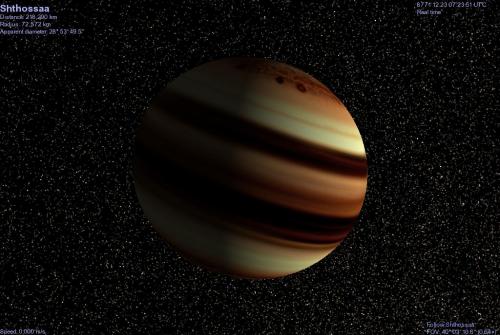 Image from Steve Bowers | |
| Shthossaa, a gas giant in the H'tat'sa'thoss system | |
Society
Unlike GAIA, the Caretaker of Tohul permits significant numbers of visitors, and there is even some immigration to and emigration from the To'ul'h homeworld. The diversity of nations and cultures is huge; it appears nearly all the traditional pre-contact cultures are represented somewhere on the planet, as well as many new forms. Only baseline or nearbaseline To'ul'hs are allowed to retain residency and even xenoprovolves derived from other To'ul'hese life forms are only permitted to visit, not to colonize. O'hoth'so'toh (Smoking Mirror) has given no reasons for this restriction. Though O'hoth'so'toh has ordained no absolute restrictions on the use of technology, no action that would disrupt the ecology of Tohul as it was before Terragen contact is permitted, and neither is any action what would lead to the extinction of any local species. In practice, many of the local cultures are Ludd, Prim or Lo Tek in nature; few use anything more than simple wind or water powered electrical generators and some well tested gengineered or seed nanotech items. More powerful or novel technologies are under severe legal and cultural constraints. Simple sustainable agriculture and ranching, in the style of the sophisticated "polyculture" developed by To'ul'h civilisations before Terragen contact, is quite common. Within the guidelines lain down by the planetary authorities the locals are apparently self-governing. O'hoth'so'toh rarely interferes directly in local affairs, or even in disputes between different polities, other than to prevent meddling by off-planet agencies. It is assumed, though not proven, the e does maintain the memetic balance to prevent entire societies from violating ecological restrictions, or from taking up the use of "disruptive" technologies. Violators or protesters against these restrictions may be dealt with either harshly or gently by the local authorities according to the preference of the society in question, though in most places the solution is voluntary emigration or forced exile.Other than the fact that all of the existing cultures abide by O'hoth'so'toh's rule, and seem to tend "naturally" more toward the ancient To'ul'h Sisyphean/Homeworlder cluster of philosophies (comparable in some ways to aspects of Old Earth Taoism, Shinto, or Gaianist belief) than the equally ancient Promethean/Spacer school of thought, there is very little that unites them, other than characteristics that arise naturally from the To'ul'h species itself. The most populous nations have an international forum for debate, but it has very little force locally and many regions are not members. Educated or travelled individuals all speak To'ul'hoss to some degree, and use the common ceremonial calendar. There are some planet-wide trends in polmusic, and there are traditional athletic competitions, held in one of the major cities each ceremonial year that are open to any qualifying baseline or nearbaseline To'ul'h. However, these are relatively weak common elements.
Though superficially O'hoth'so'toh is more open to the outside world than other Caretakerist archailects, and is certainly much less secretive than GAIA, it is not at all clear what eir objectives actually are. Though the planetary biosphere has been restored to its pre-contact state (including considerable areas of rangeland or farmland on the surface), the To'ul'h cultures have not been forced back into their old mould. Traditional To'ul'hese memes are dominant, but Terragen influences are not at all unknown. Locals believe that this is a deliberate policy to encourage whatever is unique ("preserving specificity as well as species" as some local thinkers phrase it) even at the expense of some older cultures and memes.
Cities and Installations
Most of the ancient cities of pre-contact To'ul'h are still in existence, or if they were rebuilt or razed during the Spacer hegemony they have been restored. These are simply too numerous and diverse to describe individually. The extensive arcologies of the Spacer era have been dismantled, excepting a ruin that was at the site of the former Beanstalk terminus during the "Spacer Tyranny". This has been abandoned to the elements and to pilgrims and tourists, as a sort of memorial by the local polity. The bustling cities around the Narrow Sea are justly famous, as are the highland ranches, market towns, and monastic communities. Many are superficially much the same as they have been for thousands of years. The famed cliff cities, former seat of the famous skywhale hunting cultures, are still inhabited, though the great palaces are no longer maintained as residences. The controversial archaeological sites in the Ss'oth highlands, and their associated settlements of Progenitists are perhaps the most recent of Tohul's many historical marvels.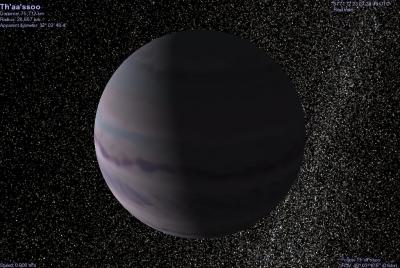 Image from Steve Bowers | |
| Th'aa'ssoo, a cryojovian in the Tohul system | |
History
There is no part of the planet that does not have some trace of past intelligent life, whether it is as subtle as arrow-heads in the local gravel pits, or the remains of mines or the foundations of dwellings or traces of the irrigation ditches and wind-powered pumps that characterize To'ul'h "farming". The To'ul'h knew the use of the wheel, sails, windmills, written records, and their own peculiar version of agriculture long before humans so much as learned to shape a digging stick or chip a hand axe. Civilization on Tohul extends back approximately one hundred thousand years, and though no one culture or polity has lasted even a small fraction of that time the accumulated effects are felt everywhere.To'ul'h civilizations have risen, fallen, and been succeeded by others time after time without crossing the critical threshold into a culture transformed by science and technology. The To'ul'h mode of intelligence is so clearly suited to technology that initially students were quite puzzled that such a species existed for so long without developing an Industrial, Information, or Interplanetary age as happened on Old Earth. The common consensus is that this seemingly peculiar fact arises not from any factor unique to To'ul'h psychology but from the constraints of the planetary environment. Civilizations on Old Earth depended strongly for their rise on the advent of agriculture, on the use of animal labour, and on fossil fuels, before they learned to harness solar and nuclear inputs. Key rungs in this ladder are missing on To'ul'h. The surface equivalent of plant life is less productive per hectare, and less predictable in its output, than the vegetation on a standard Gaian world since it is merely consuming energy produced in the photic zone above. Metallurgy had a muted effect, since most metals corrode rapidly in the acidic rains unless they are kept dry or oiled against contact. Steam engines are possible at such high pressures, but the boiling point of water is highly elevated, and fires tend not to burn hot in such a carbon dioxide rich and oxygen poor atmosphere. Finally, and perhaps most tellingly, there are neither great stocks of combustible biomass comparable to the forests of a standard Gaian planet, nor any significant deposits of fossil fuels other than tar sands and carbonaceous shales. The necessary energy bonus to boost To'ul'hs into an Interplanetary Age simply did not exist. Wind and water powered devices did eventually become commonplace in heavily settled regions, as did dirigibles. Such things as batteries, dynamos, and methane-powered internal combustion engines were developed at various periods of history, and later rediscovered in old manuscripts or reinvented entirely, but they remained local curiosities. Assembly line manufacture was occasionally used in some monastic communities or in large government controlled facilities for the production of specialized goods, but never became widespread.
Perhaps the closest approach to a Terragen style industrial culture came during the various "skywhaler" polities that arose periodically over the course of To'ul'h history (the last arose and fell between 7500 and 7000 BT). These made dirigibles capable of travelling into the cold upper airs and tapped the relatively rich resources of the photic zone. However, each of these eventually overran the available supply of skyfauna and cloudforests. This had devastating effects on the ecology below, including disruptions in the local weather, famines related to a cessation of the rain of nutrients to the surface, and even a few instances of mass die-off in the skyplankton. Subsequent religious figures and philosophers characterized such activities as foolish at best and sinful at worst, and memes against such meddling were found in nearly every well established culture.
Over the course of time a kind of natural selection weeded out those To'ul'h cultures incapable of living within their means. Technology continued to inch slowly forward, with many reverses, but might never have led the To'ul'h to Interplanetary levels even over the entire lifetime of the species. At the time of contact, even the most advanced To'ul'h thinkers were unaware of the existence of other worlds, other than in speculative fantasies. The dominant meta-culture that enfolded most of Tohul before Terragen contact was well adapted to To'ul'h survival, however. The To'ul'hoss language still in use today was not only a lingua franca or pidgin among the traders and diplomats of pre-contact To'ul'h but a common language for scholars and priests across the ages. Its roots extend back over 30,000 years, and records written by civilizations long lost to living memory can still be deciphered by ordinary To'ul'hs even today if they were written in that age's version of To'ul'hoss rather than in some forgotten language. Even the greatest of To'ul'h civilizations were strongly conscious of their relative youth compared to the ancients, and planned to some degree to be well remembered when after hundreds or thousands of years they inevitably fell. Terragen contact was a profound disruption to a world that had reached a steady state. This balance has never since been fully restored to what it was, though the present transapient ruler, O'hoth'so'toh, has re-established an approximation of that state for inscrutable reasons of eir own (see the To'ul'h species entry for more details).
Timeline | |
| 400,000 BT | First fully modern baseline To'ul'hs become distinct from pre-To'ul'h species; most live as bands of omnivorous semi-nomadic foragers, in a manner strikingly similar to that of baseline humans. |
|---|---|
| 95,000 BT | To'ul'h civilization gradually and belatedly enters its equivalent of Old Earth's Agricultural Age (sometimes called the Ceramic/Obsidian Age after its primary material technology, and roughly equivalent to the Earth's Iron Age). With occasional excursions on the part of some individuals and polities into other technologies (batteries, dirigibles, steam engines) this complex series of culture remains more or less stable for hundreds of thousands of years and leaves its mark all over the planet. Environmental factors prevent the development of Industrial style civilisations; instead civilised life waxes and wanes on various parts of the planet according to climate and politics. |
| 30,000 BT | Probable origin of To'ul'hoss meta-language, as seen in written documents |
| 7500 BT | Fall of the most recent To'ul'h skywhale hunting cultures |
| 3831 AT | The To'ul'hs are discovered by the MPA exploration agent Fortunate Cloud, who had been using a research swarm to explore the system's planets in detail. They are the first living and unequivocally sophont alien clade to be discovered within the sphere of Terragen expansion. No communication is made until observations are completed. |
| 4011 AT | Terragen contacts with several of the To'ul'h cultures. Any interested To'ul'h are invited to join the Terragen civilisations, and many prove highly receptive to Terragen technology and ideas. To'ul'h ideas sparks a renaissance era in many Terragen cultures. |
| 4300 AT | To'ul'h have acquired Terragen technologies and fully integrated them into their cultures; they interact with the many compatible Terragen clades, in some cases forming new hybrid cultures. |
| 4318 AT | The first humans to be killed by through direct contact with living xenosophonts in a face-to-face confrontation. This occurs during a riot on Eithne, the orbital installation orbiting Tohul. A rumour had spread among the To'ul'hs that members of a recently arrived team of Miramar tweaks were planning to attempt to eat a dead To'ul'h. This is a religious practice common to several major religions on Tohul, but considered blasphemous when done by unbelievers. In the ensuing chaos two humans and three To'ul'hs are killed. |
| 4511 AT | Increasing differences between the 'Promethean' Spacer To'ul'hs and post To'ul'hs and the 'Sisyphean' To'ul'hs (and some post-To'ul'hs) dominant on the homeworld and in the home system leads to the first true To'ul'h- To'ul'h wars since Terragen contact: the Spacer/Homeworlder wars. After several decades of interference and sporadic warfare the Spacers establish a technocratic dictatorship on Tohul. |
| 4528 AT | The To'ul'h Homeworlders, with help from sympathetic Terragen organisations, stage a bloody revolution and oust the Spacers. |
| 4645 AT | The Spacers' final assault on Tohul is stymied when the Caretaker God known as Smoking Mirror declares the To'ul'h system its domain and places it under the Compact of Eden. |
Visiting
The wormhole link to the system is not large, though the resident wormhole guardian provides free passage to nearly any sophont and most transapients. Travel within the system, by any means, is apparently under observation by O'hoth'so'toh or eir agents, but e does not interfere with any traffic unless it is bound for or will affect Tohul. The system's diverse polities each have their own jurisdictions, and answer only to a loose federation known as the To'ul'h Spacers Guild. Travellers who intend to visit Tohul generally are advised to make arrangements with local agents in one of the insystem polities as well as with representatives of O'hoth'so'toh, since no direct travel to Tohul is allowed. One must first stop elsewhere in the system's polities, then if permission is granted, to one of Tohul's orbital stations, and from there by lander to the surface. O'hoth'so'toh dismantled the planet's beanstalk facilities shortly after evicting the Spacers, and permits no more than one landing per day on the planet, at one of the eight designated landing sites. Passage offworld is facilitated via high altitude dirigibles followed by a short rocket launch and skyhook capture. Visitors should be aware that local transportation facilities are limited, and that if they are not naturally equipped to survive To'ul'hese conditions any survival suits should be capable of self-repair. By local custom (and implicitly by O'hoth'so'toh's command) there are no facilities catering specifically to offworld visitors who require anything more than a native To'ul'h might. Agents of O'hoth'so'toh determine the allowable stay of each individual according to eir own criteria. The precise method of enforcement is unknown, but those who overstay their welcome grow increasingly uneasy, then sicken or malfunction. They typically die if they are not either offplanet or en route to a landing site within the prescribed time. Over the course of time there have been exceptions to this rule, and some individuals have apparently been allowed to stay as resident aliens, usually in one of the major To'ul'h cities or monastic complexes. All have proved to be infertile, however; there are no resident populations of non-To'ul'h.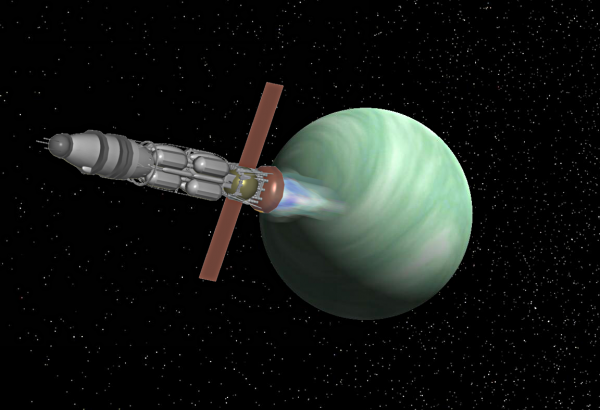 Image from Steve Bowers | |
| The sentient ship 'Fortunate Cloud' decelerates into orbit around To'ul'h Prime, prior to first contact with the intelligent species there | |
Related Articles
- Garden Worlds
- H'me'ch
- H'tat'sa'thoss (JD 870135)
- Ho'th'hss'lho (Politician)
- Hos’tho (Famous Healer)
- King Ho'than'shi II of Gla'shoo'ath
- Shur'rooss'hur
- Spockbat
- To'ul'h Calendar, The
- To'ul'ho'lo'ss (Language)
- To'ul'human - Text by Steve Bowers
Homorph To'ul'h who have been given or adopted human shape by advanced biotech. They also can take To'ul'h form in earthlike environments or adapted human form in toulovenusian environments. - Tohul Fauna
- Tohulian Worlds
Appears in Topics
| Caretaker Gods | Middle Regions/Hinter-regions | Mutual Progress Association |
| Systems & Worlds S - T | To'ul'hs |
Development Notes
Text by Stephen Inniss
Updated by Dangerous Safety and The Astronomer 2021
Initially published on 22 July 2006.
Fixed the problem about the Biology and Ecology's text not fully appearing, and removing duplicate information related to the system and the star, which can already be viewed in the H'tat'sa'thoss article (system article) itself. (2023-01-30, by The Astronomer)
Updated by Dangerous Safety and The Astronomer 2021
Initially published on 22 July 2006.
Fixed the problem about the Biology and Ecology's text not fully appearing, and removing duplicate information related to the system and the star, which can already be viewed in the H'tat'sa'thoss article (system article) itself. (2023-01-30, by The Astronomer)

